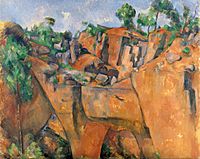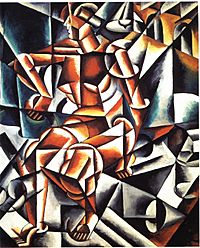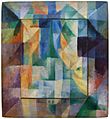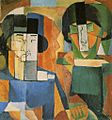Cubism facts for kids


Cubism was one of the most significant art movements of the 20th century. It began in France about 1907, and flourished from 1910 through the 1920s. It was pioneered by Georges Braque and Pablo Picasso.
Pablo Picasso's 1907 painting Les Demoiselles d'Avignon was an early Cubist work. Georges Braque's 1908 Houses at L’Estaque (and related works) prompted the critic Louis Vauxcelles to refer to "bizarreries cubiques" (cubic oddities).
The first organized group exhibition by Cubists took place at the Salon des Indépendants in Paris in the spring of 1911. It included works by Jean Metzinger, Albert Gleizes, Fernand Léger, Robert Delaunay and Henri Le Fauconnier, but no works by Picasso and Braque were exhibited.
According to one art historian, there were three phases of Cubism. There was "Early Cubism", (from 1906 to 1908) when the movement was initially developed by Picasso and Braque. In the second phase, "High Cubism", (from 1909 to 1914), Juan Gris emerged as an important exponent after 1911. Finally "Late Cubism" (from 1914 to 1921) was the last phase of Cubism as a radical avant-garde movement. Douglas Cooper's emphasis on the work of Braque, Picasso, Gris (from 1911) and Léger (to a lesser extent) was an intentional value judgement.
Its methods
Cubism is a style of art which aims to show all of the possible viewpoints of a person or an object all at once. It is called Cubism because the items represented in the artworks look like they are made out of cubes and other geometrical shapes. Cubism was first started by Pablo Picasso and Georges Braque. Analytical Cubism is the first type of cubism. Most analytical Cubists painted and drew in monochrome (only one colour) so that the person who was looking at the painting did not pay attention to colour, but only to the shapes and the forms that were being shown.
This was changed in 1912 when Picasso first started painting with colours and using collages. Collage is when you glue together different cut-up pieces of paper to make an artwork. This new form of Cubism was called Synthetic Cubism. Picasso invented collage because he was tired of the way he was making his art, and wanted to try out something new. Pablo Picasso created over 20,000 pictures. From 1912 to 1919 was Picasso's Synthetic Cubism Period.
Images for kids
-
Albert Gleizes, L'Homme au Balcon, Man on a Balcony (Portrait of Dr. Théo Morinaud), 1912, oil on canvas, 195.6 × 114.9 cm (77 × 45 1/4 in.), Philadelphia Museum of Art. Completed the same year that Albert Gleizes co-authored the book Du "Cubisme" with Jean Metzinger. Exhibited at Salon d'Automne, Paris, 1912, Armory show, New York, Chicago, Boston, 1913
-
The "Cubists" Dominate Paris' Fall Salon, The New York Times, October 8, 1911. Picasso's 1908 Seated Woman (Meditation) is reproduced along with a photograph of the artist in his studio (upper left). Metzinger's Baigneuses (1908–09) is reproduced top right. Also reproduced are works by Derain, Matisse, Friesz, Herbin, and a photo of Braque
-
Robert Delaunay, Simultaneous Windows on the City, 1912, 46 x 40 cm, Hamburger Kunsthalle, an example of Abstract Cubism
-
The Salon d'Automne of 1912, held in Paris at the Grand Palais from 1 October to 8 November. Joseph Csaky’s sculpture Groupe de femmes of 1911–12 is exhibited to the left, in front of two sculptures by Amedeo Modigliani. Other works by Section d'Or artists are shown (left to right): František Kupka, Francis Picabia, Jean Metzinger and Henri Le Fauconnier.
-
Paul Cézanne, Quarry Bibémus, 1898–1900, Museum Folkwang, Essen, Germany
-
Diego Rivera, Portrait de Messieurs Kawashima et Foujita, 1914
-
Le Corbusier, Assembly building, Chandigarh, India
-
Le Corbusier, Centre Le Corbusier (Heidi Weber Museum) in Zürich-Seefeld (Zürichhorn)
-
House of the Black Madonna in Prague, built by Josef Gočár in 1912
-
Georges Braque, 1909–10, La guitare (Mandora, La Mandore), oil on canvas, 71.1 x 55.9 cm, Tate Modern, London
-
Albert Gleizes, 1910, La Femme aux Phlox (Woman with Phlox), oil on canvas, 81 x 100 cm, Museum of Fine Arts, Houston. Exhibited in Room 41, Salon des Indépendants 1911, Armory Show 1913
-
Georges Braque, 1910, Violin and Candlestick, oil on canvas, 60.96 x 50.17 cm, San Francisco Museum of Modern Art
-
Robert Delaunay, 1910–11, La ville no. 2, oil on canvas, 146 x 114 cm, Musée National d'Art Moderne, Paris
-
Marcel Duchamp, 1911, La sonate (Sonata), oil on canvas, 145.1 x 113.3 cm, Philadelphia Museum of Art
-
Fernand Léger, 1911–1912, Les Fumeurs (The Smokers), oil on canvas, 129.2 x 96.5 cm, Solomon R. Guggenheim Museum, New York
-
Georges Braque, 1911–12, Man with a Guitar (Figure, L’homme à la guitare), oil on canvas, 116.2 x 80.9 cm, Museum of Modern Art
-
Jacques Villon, 1912, Girl at the Piano (Fillette au piano), oil on canvas, 129.2 x 96.4 cm, oval, Museum of Modern Art, New York. Exhibited at the 1913 Armory Show
-
Francis Picabia, 1912, La Source (The Spring), oil on canvas, 249.6 x 249.3 cm, Museum of Modern Art, New York
-
Albert Gleizes, 1912–13, Les Joueurs de football (Football Players), oil on canvas, 225.4 x 183 cm, National Gallery of Art, Washington D.C.
-
Juan Gris, 1915, Nature morte à la nappe à carreaux (Still Life with Checked Tablecloth), oil and graphite on canvas, 116.5 x 89.2 cm, Metropolitan Museum of Art, Leonard A. Lauder collection
-
Diego Rivera, 1915, Portrait of Ramón Gómez de la Serna, 109.6 × 90.2 cm. Latin American Art Museum of Buenos Aires
-
Juan Gris, October 1916, Portrait of Josette, oil on canvas, 116 x 73 cm, Museo Reina Sofia, Madrid
-
Pablo Picasso, 1918, Arlequin au violon (Harlequin with Violin), oil on canvas, 142 x 100.3 cm, The Cleveland Museum of Art, Ohio
-
Gino Severini, 1919, Bohémien Jouant de L'Accordéon (The Accordion Player), Museo del Novecento, Milan
-
Albert Gleizes, 1920, Femme au gant noir (Woman with Black Glove), oil on canvas, 126 x 100 cm, National Gallery of Australia
See also
 In Spanish: Cubismo para niños
In Spanish: Cubismo para niños


































